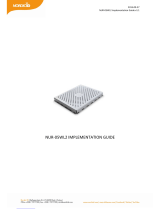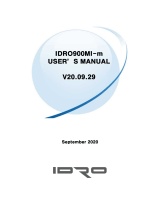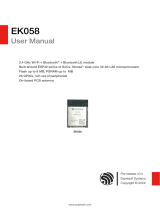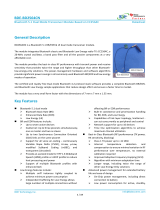Honeywell IM11-PRT RFID Module Manuel utilisateur
- Taper
- Manuel utilisateur

Honeywell Confidential and Proprietary
USER MANUAL
IM11-PRT RFID MODULE
Revision
MODEL NO:IM11-PRT RFID MODULE

Table of Contents
Introduction ....................................................................................................... 1
Technical Specifications ................................................................................... 3
Mechanical Integration ...................................................................................... 7
Electrical Integration ......................................................................................... 8
Power Requirements ....................................................................... 8
Reader Power States ...................................................................... 9
Supported Antennas: ...................................................................................... 10
Mini-PCI Connector Pin Descriptions .............................................................. 11
Agency Approvals ........................................................................................... 14
FCC Communications commission interface statement ................ 14
Industry Canada .......................................................................... 17

1
Introduction
This document specifies the details for a IM11-PRT RFID MODULE
About IM11
IM11-PRT RFID Reader Module is designed for quick integration into computers,
printers, and any other products that need to be RFID-enabled. The IM11 includes these
features:
Allows the RFID-enabled product to read and write to tags used in most
worldwide applications:
•
The IM11 can comply with the regulatory requirements for
ETSI 4 channels in
Europe, USA, Taiwan, Australia, Thailand,
Brazil, Hong Kong, Malaysia,
Singapore, China, Philippines, South Africa, Israel, South Korea, and New
Zealand.
•
The IM11 cannot comply with regulatory requirements for Japan.
•
Operates across the entire frequency band. The country code
defines the
frequency bands of operation, the power levels, the hop tables, and other country-
specific parameters. The default country
code is defined by the location where the
Chapter

2
module is delivered.
•
Covers UHF bands from 865 to 928 MHz Supports four channel operation over the
865 to 868 MHz band.
•
Supports 50 channels in the FCC band from 902 to 928 MHz.
•
Supports the ISO 18000-6c protocol (EPC Class 1, Gen 2)
•
Supports the BRI (Basic Reader Interface) host communication protocol.

3
Technical Specifications
Physical Specifications
Physical 50.95 mm long x 30 mm wide x 4.76 mm thick
Weight
Environmental Specifications
Operating
Temperature
Storage
Temperature
-20 °C to +60 °C
-40 °C to +70 °C
Humidity 25 °C to 60 °C, 0% to 95% relative humidity,
non-condensing process
Shock
2000 g, 0.5 ms pulse, 10 times on each axis
Vibration GRMS. 10 to 500 Hz, in 3 axis
ESD
Passes CE mark requirements. 4 kV contact discharge and 8
kV air discharge, while unpowered.
Chapter
Specification
Values
Specification
Values

4
Transmitter Specifications
Specification
Minimum
Typical
Maximum
Unit
Notes
Frequency -20 +20 PPM
Stability
Spurious -55 dBc In band
Emissions
-
-
50
dBc
Out of band
FCC
Spurious
-
54
dBm
Out of band
Emissions
-
ETSI

5
Thermal
85
°C
As measured by
Shutdown
sensor on module
Thermal
75
°C
Recovery
Transceiver Specifications
Output Power Control 29.5 dBm. User adjustable in 1 dB down to
10.5 dBm. Tolerance drift from +0.5 to -0.7.
Bus Interface (USB or serial) USB 2.0 compliant client 12 Mbps (full speed)
Serial 115.2 Kbps
RF Output Impedance 50 Ohms with better than 10 dB return loss
Modulation PR-ASK
Data Encoding DRM or FM0
RF Sensitivity DRM: Monostatic 15 dB S/N Power [dBm]
ON: -70 dBm
RF sensitivity is the minimum RF conducted
power for measuring a given 15 dB return loss
on the antenna port.
Tags/Protocols Supported
EPC Class 1 Gen 2, UHF Version 1.2.0
ISO 18000-6C
NXP SL3ICS1002 G2XM, can read 512-bit
extended user memory and custom
commands
Fujitsu FJ64 Kb
Impinj Monza 4QT
Tag Data Rate EPC Class 1 Gen2, ISO 18000-6C
DRM back link frequency up to 320 KHz
FM0 back link frequency 160 KHz
Read Range
>6 m (20 ft), provided that the module:
•
is using DRM operation mode.
•
isconnected to an antenna system with 9
dBiC gain (circular polarized).
•
has no occurrence of multipath or other
environmental interference.
Read Speed >200 tags per second (using 32 conducted
Specification
Values

6
tags)
50 tags per second (using over air tags)
Performance Testing
AD 223 tags on cardboard
Receiver Specifications
Sensitivity Typical: -70 dBm
15 dB return loss
Maximum Reverse Input Power Maximum: +20 dBm
Receiver Input
Values

7
Mechanical Integration
The module fits within the Mini PCI Express specifications.
For physical dimensions, see the illustration.

8
Electrical Integration
The module communicates either over USB or through serial:
The USB client communication follows the CDC profile and is USB 2.0-
compliant, operating at 12 Mbps (full speed).
In Serial mode, the module communicates as a standard PC COM port, operating
at 115.2 Kbps. It has eight general purpose inputs and outputs for monitoring and
controlling external signals.
A Digital Signal Processor (DSP) controls the radio functions and provides
communication with the host. This interface allows direct reprogramming and
updating of the on-board FLASH memory
Power Requirements
The module operates off power input from 3.15 VDC to 5.2 VDC. If the input is
3.3 V DC or less, you must account for significant increased current demand. If the
input drops below 3.15 VDC, 1 Watt output is not possible.
The module handles its own power management and goes into Standby
mode automatically when there are no outstanding
commands. However, even in
Standby mode, the IM11 immediately
responds to host activity, eliminating any
potential host timeout conditions.
To achieve an even lower power Standby mode, the host needs to
support
USB suspend and remote wakeup.

9
To reduce power, the module duty cycles its transmitter. The duty cycling
happens according to the read commands that the application executes. To achieve the
lowest power, after all tags are read, the transmitter turns off. After a period of time, the
transmitter activates to identify new tags in the field. After all new tags are read, the
transmitter turns off for the rest of the period.
Also, the module automatically reduces the power out if the input voltage is too low
or the temperature of the module is too high.
Reader Power States
There are four different power states for the RFID module.
Reader Power States and Levels of Consumption
Off 0 (3.3 V turned off to the module)
Deep Sleep • 3.3 V on
•
RF enable = Off
•
< 1 mA
•
Real Time Clock (RTC) = On (< 100 μA to power RTC)*
•
Enable (Pin 20) is low
Idle • 3.3 V on
•
RF enable = On
•
No USB activity
•
About 35 mA
•
Enable (Pin 20) is high
Read Max current during tag read about 1.5 A
*You cannot turn off the RTC unless you remove power Pin 2 (VBATT)
on the mini-PCI connector.
Power State
Level of Consumption

10
Supported Antennas:
These antennas are approved to work with iM11:
Compact Yagi (6.0 dBi Linear)
Microstrip Antenna, "Coupler” with -19.96 dBi gain
Microstrip Antenna, "Coupler” with -24 dBi gain

11
Mini-PCI Connector Pin
Descriptions
Pin Descriptions
Chapter
Pin Pin Name
Description
1
Reserved
Do NOT connect
2
+V_BATT Power input
3
Reserved
Do NOT connect
4
GND
Ground
5
No Connect Not connected
6
GPIO2
7
No Connect Not connected
8
No Connect Not connected
9
GND
Ground
10 No Connect Not connected
11 No Connect Not connected
12 No Connect Not connected
13
Reserved
Do NOT connect
14 No Connect Not connected
15
GND
Ground
16 GPIO0
17
Reserved
Do NOT connect
18
GND
Ground
19
Reserved
Do NOT connect
20 ENABLE Input. Logic high level turns on
power to IM11
21
GND
Ground
22 UART_SEL_L Input. Low level activates UART
instead of USB (at Enable active)
23
Reserved
Do NOT connect
24 +V_BATT
Power input
25
Reserved
Do NOT connect

12
Notes:
•
GPIOx: General purpose inputs/outputs. The pins are high impedance
inputs when initially powered, following a module reset. You can
configure all pins as inputs or outputs under software control.
•
Host TX1/RX1 and host RTS1/CTS1: Standard logic levels. No RS-232
transceiver.
•
USB_DP: If UART_SEL_L is low, pull up to wake up. If logic level is low,
IM11 is in Sleep mode.
•
All signals are 3.3 V logic levels (5 V tolerant inputs).
26
GND
Ground
27
GND
Ground
28 GPIO1
29
GND
Ground
30 GPIO3
31
Reserved
Do NOT connect
32 GPIO4
33 RESET_L Logic low level resets IM11
34
GND
Ground
35
GND
Ground
36 USB_DM USB data minus
37
GND
Ground
38 USB_DP USB data plus
39 +V_BATT
Power input
40
GND
Ground
41 +V_BATT
Power input
42 No Connect Not connected
43
GND
Ground
44 GPIO5
45 HOST_CTS1 Future use
46 GPIO6
47 HOST_RTS1 Future use
48 GPIO7
49 HOST_RX1
Output. Rx data output to host
50
GND
Ground
51 HOST_TX1
Input. Tx data input from host
52 +V_BATT
Power input

13
Input and Output Voltage Level Descriptions
Transmit Power
The module is able to adjust transmit power from 29.5 dBm to10.5 dBm,
configurable in 1 dB steps with an accuracy (the measure of the power output for
each level) of +/-0.5 dB. The initial tolerance (the measure of the power output for
each level) is +/-0.5 dB. The output power is set on each of the antennas. Output
power tolerance from the nominal setting is +/- 0.75 dB over an ambient
temperature range of -20 °C to 60 °C.
The module supports PR-ASK modulation for EPC Class 1 Gen 2 tags only.
RF Integration
The module supports two antenna connections. You can use software
to
control the selection of either connection. The module switches from one
antenna to the other in 5 ms or less. The switching time is defined from the 90%
power point as the RF is turned off at the first port to the 90% power point as the
RF is turned on at the second port.
The module uses an integrated RFID transceiver. It features autotuning on
the antenna ports to match the antenna return loss
dynamically. The system
compensates for antennas with a VSWR of 2.0
or lower (a VSWR of <1.7 is
optimum).
There are no termination requirements for the antenna ports. The module will not
transmit to any open antenna ports

14
Agency Approvals
FCC Communications commission interface statement
Model: IM11PRT
FCC ID: HD5-IM11R
This device complies with Part 15 of the FCC Rules. Operation is subject to
the following two conditions:
1. This device may not cause harmful interference.
2. This device must accept any interference received, including, an
interference that may
cause undesired operation.
This equipment has been tested and found to comply with the limits for a Class B
digital device, pursuant to Part 15 of the FCC Rules. These limits are designed to
provide reasonable protection against harmful interference in a residential
installation. This equipment generates, uses and can radiate radio frequency
energy and, if not installed and used in accordance with the instructions, may cause
harmful interference to radio communications. However, there is no guarantee that
interference will not occur in a particular installation. If this equipment does cause
harmful interference to radio or television reception, which can be determined by
Chapter

15
turning the equipment off and on, the user is encouraged to try to correct the
interference by one or more of the following measures:
• Reorient or relocate the receiving antenna.
• Increase the separation between the equipment and receiver.
• Connect the equipment into an outlet on a circuit different from that to which the
receiver is connected.
• Consult the dealer or an experienced radio/TV technician for help.
FCC Caution: Any changes or modifications not expressly approved by the party
responsible for compliance could void the users authority to operate this equipment
This transmitter must not be co-located or operating in conjunction with any other
antenna or transmitter.
Radio exposure statement:
This equipment complies with FCC radiation exposure limits set fourth for an
uncontrolled environment. This equipment should be installed and operated with
minimum distance 20cm between the radiator & your body.
This device is intended only for OEM integrators under the following
conditions:
1) The antenna must be installed such that 20cm is maintained between the
antenna and users.
2) The transmitter module may not be co-located with any other transmitter or
antenna
As long as 2 conditions above are met, further transmitter test will not be required.
However, the OEM integrator is still responsible for testing their end -product for any
additional compliance requirements required with this module installed.

16
IMPORTANT NOTE: In the event that these conditions can not be met (for example
certain laptop configurations or co-location with another transmitter), then the FCC
authorization is no longer considered valid and FCC ID can not be used on the final
product. In these circumstances, the OEM integrator will be responsible for re-
evaluating the end product (including the transmitter) and obtaining a separate FCC
authorization.
End Product Labeling:
This transmitter module is authorized only for use in device where the antenna may
be installed such that 20cm may be maintained between the antenna and users.
The final end product must be labeled in visible area with the following: “Contains
FCC ID: HD5-IM11R”. The grantee’s FCC ID can be used only when all FCC
compliance requirements are met.
Manual Information to the end user:
The OEM integrator has to be aware not to provide information to the end user
regarding how to install or remove this RF module in the user's manual of the end
product with integrates this module. The end user manual shall include all required
regulatory information/warning as shown in this manual.

17
Industry Canada
Model: IM11PRT
IC: 1693B-IM11R
This device complies with ISED's license-exempt RSSs. Operation is
subject to the following two conditions:
(1) this device may not cause harmful interference, and
(2) this device must accept any interference, including interference that may cause
undesired operation of the device.
Cet appareil est conforme aux RSS exemptés de licence de l’ISED.
L’opération est soumise aux deux conditions suivantes : (1) cet appareil peut
ne pas causer d’interférences nocives, et (2) cet appareil doit accepter toute
interférence, y compris les interférences qui peuvent provoquer un
fonctionnement non désiré de l’appareil.
Radiation Exposure Statement:
This equipment complies with ISED radiation exposure limits set forth for an
uncontrolled environment. This equipment should be installed and operated with
minimum distance 20cm between the radiator & your body.
Déclaration sur l’exposition aux rayonnements :
Cet équipement est conforme aux limites d’exposition aux rayonnements
ISED établies pour un environnement non contrôlé. Cet équipement doit être
installé et actionné avec la distance minimale 20cm entre le radiateur et votre
corps.

18
DETACHABLE ANTENNA USAGE
This radio transmitter (IC: 1693B-IM11R/ Model: IM11-PRT) has been approved by
ISED to operate with the antenna type listed below with maximum permissible gain
indicated. Antenna types not included in this list, having a gain greater than the
maximum gain indicated for that type, are strictly prohibited for use with this device.
Approved antenna’s list
Cet émetteur radio (IC : 1693B-IM11R/ Modèle : IM11-PRT) a été approuvé
par l’ISED pour fonctionner avec le type d’antenne énuméré ci-dessous avec
un gain maximal autorisé indiqué. Les types d’antennes non inclus dans cette
liste, ayant un gain supérieur au gain maximum indiqué pour ce type, sont
strictement interdits d’utilisation avec cet appareil.
This device is intended only for OEM integrators under the following
conditions: (For module device use)
1) The antenna must be installed such that 20cm is maintained between the
antenna and users.
2) The transmitter module may not be co-located with any other transmitter or
antenna.
As long as 2 conditions above are met, further transmitter test will not be required.
However, the OEM integrator is still responsible for testing their end -product for any
additional compliance requirements required with this module installed.
La page est en cours de chargement...
La page est en cours de chargement...
-
 1
1
-
 2
2
-
 3
3
-
 4
4
-
 5
5
-
 6
6
-
 7
7
-
 8
8
-
 9
9
-
 10
10
-
 11
11
-
 12
12
-
 13
13
-
 14
14
-
 15
15
-
 16
16
-
 17
17
-
 18
18
-
 19
19
-
 20
20
-
 21
21
-
 22
22
Honeywell IM11-PRT RFID Module Manuel utilisateur
- Taper
- Manuel utilisateur
dans d''autres langues
Documents connexes
Autres documents
-
Intermec IM11 Integration Manual
-
Kärcher 4.683-250.0 Manuel utilisateur
-
vayyar VMAKERPROUWB Manuel utilisateur
-
vayyar VMAKERPROUWB Manuel utilisateur
-
 Nordic ID SCCNUR05WL2 Manuel utilisateur
Nordic ID SCCNUR05WL2 Manuel utilisateur
-
 IDRO 00MI UHF RFID Reader Module Manuel utilisateur
IDRO 00MI UHF RFID Reader Module Manuel utilisateur
-
 Espressif EK058 2.4 GHz WiFi Bluetooth LE Module Manuel utilisateur
Espressif EK058 2.4 GHz WiFi Bluetooth LE Module Manuel utilisateur
-
LG MB3021 Bluetooth 5.1 Smart Device Module Manuel utilisateur
-
Telit Wireless Solutions LN940 WWAN M.2 Manuel utilisateur
-
 BDE BD2564CN Bluetooth 5.1 Dual Mode Transceiver Module Based on CC2564C Manuel utilisateur
BDE BD2564CN Bluetooth 5.1 Dual Mode Transceiver Module Based on CC2564C Manuel utilisateur

























